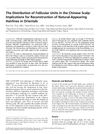Gigasessions With Combination of FUT and FUE in Asians
September 2017
TLDR Combining FUT and FUE techniques improves hair transplant results for severe baldness in Asians.
The document discussed the challenges and advancements in hair transplantation for patients with high levels of male pattern baldness, particularly in Asians. It highlighted the need for large numbers of follicular units (FUs), ranging from 6,000 to 12,000, to achieve satisfactory results in patients with Norwood class V–VII hair loss. The study introduced a technique combining follicular unit transplantation (FUT) and follicular unit extraction (FUE) to maximize donor harvesting and reduce scalp tension during wound closure. This approach allowed for the transplantation of 4,000 to 8,000 FUs, even in patients with average and low scalp laxity, thereby improving outcomes in extensive hair transplant surgeries.







